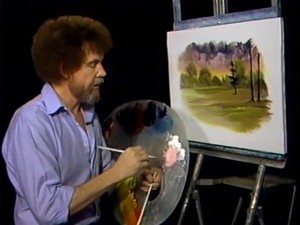Small-Screen 66 – #63: “The Joy of Painting”
[and “Mr. Rogers’ Neighborhood” and “How It’s Made”]
(PBS, 1983-94) / (CBC/PBS, 1963-2001) / (Discovery Channel Canada, 2001-Present)
Okay. This is definitely the most ungainly selection of the Countdown. Lumping three shows into one post may seem like cheating. Unlike Hercules and Xena, they aren’t “twin” series by any means. But I think of them as sharing a common tone. In my cerebral card catalog, all three are filed under a single keyword: Mellow. Each series features simple production values and a consistent, mild mood throughout. And despite this simplicity, they can take the most basic of tasks and subject matter and make them engrossingly watchable.
Even if you’ve never seen The Joy of Painting (finding full episodes anywhere except the shady Chinese YouTube has been surprisingly difficult), you’re probably tangentially aware of it through cultural osmosis. In each episode, host Bob Ross, rocking the most resplendent afro ever sported by a white man, leads viewers through the creation of an impromptu landscape painting. Using a “wet-on-wet” technique (not allowing paint to dry before applying other layers on top), Ross produces beautiful works of art in under a half hour.
One of the most impressive aspects of the show is the fact that it unfolds in real time. Nothing is cut out: After a brief introduction and a list of the colors viewers will need to re-create the day’s painting, Ross begins to paint. For the rest of the half hour, the two-camera setup switches between a wide shot of Ross and a close-up of the canvas. As the run-time draws to a close, Ross applies a few finishing touches and a signature to the painting.
Even if they can’t match Ross’ quick painting pace (seriously, this guy must be some kind of wizard), viewers can at least appreciate his slow, soothing voice. In fact, that voice, and the things Ross uses it to say, are the real reasons to watch this show. In an almost hypnotic tone, Ross describes each “happy little cloud” and “happy little tree” as he conjures it into being. He’s very life-affirming and motivational, too. Two of his most common catchphrases are “We don’t make mistakes…we just have happy accidents,” and “Every day’s a good day when you paint.” If you’re anxious, Bob Ross will calm you down. If you’re sad, he just might cheer you up. And if you’re high…
Well, I can’t speak from personal experience, but I did once introduce a roomful of stoners to The Joy of Painting, and let’s just say the reaction was favorable.
Now on to our two “honorable mentions” of sorts:
What can be said about Fred “Mr.” Rogers that hasn’t already been said? Rogers was a pioneer in public broadcasting, and shaped its development for some 35 years. In that time, he had an indelible influence on generations of young Americans. One of his trademark sweaters even hangs in the Smithsonian. A throwaway mention in post #63 on a small-time Facebook page hardly seems like sufficient tribute.
If this were a “greatest shows of all-time” list, Mr. Rogers’ Neighborhood would likely rank higher. But such a list is a bit beyond my scope…as I said in the 100 Film Favorites, “best of all time” is a highly subjective distinction, particularly when only one person is involved in making the judgment. Rather, this is a Countdown of MY favorite shows. And since I’m not a Mr. Rogers devotee at present, he almost missed the list entirely. Though many of the selections in this list will be heavily colored by nostalgia, my memories of the “neighborhood” aren’t as fond as some of the other kids’ shows still to come.
But if I was going to work in a Mr. Rogers shoutout, I thought it would be best to do so here. Like Bob Ross, Rogers addressed his audience on a personal level, and always in the same respectful, soothing tone. And like the third series I’ll get to in a moment, he could turn everyday objects and occurrences into captivating television. His guest “neighbors” included all sorts of artists and musicians, as well as representatives from a wide assortment of other fields. In one episode, a young breakdancer even taught him to moonwalk.
Another frequent feature was “Picture Picture,” a projector-like device which Rogers used to show shorts films, often about industrial processes, while he narrated over the footage.
From poetry readings to the making of crayons at the Binney-Smith factory, Mr. Rogers presented the simplest aspects of day-to-day life in an interesting way, and made us all feel like we belonged in the neighborhood.
Two tidbits before moving on:
-For the vast majority of his television career, Fred Rogers was based out of Pittsburgh. In the early years, local film student George Romero worked as one of his cameramen for Neighborhood. At the same time, Romero was working on his first independent feature film, Night of the Living Dead. Despite this seeming disparity, Rogers and Romero were friends for decades (although Rogers reportedly refused to let Romero cast Neighborhood regular Betty Aberlin in Night).
-Rogers was an excellent orator: In the late sixties, he spoke before congress in favor of boosting government funding to PBS. In the late 70s, he testified again in favor of the VCR (it could allow children and parents to watch “Neighborhood” together in the evenings). And when he was given a lifetime achievement award at the Daytime Emmys in 1997, he gave one of the best award speeches I’ve ever witnessed…by not speaking. In the words of journalist Tom Junod,
“Mister Rogers went onstage to accept the award — and there, in front of all the soap opera stars and talk show sinceratrons, in front of all the jutting man-tanned jaws and jutting saltwater bosoms, he made his small bow and said into the microphone, ‘All of us have special ones who have loved us into being. Would you just take, along with me, ten seconds to think of the people who have helped you become who you are. Ten seconds of silence.’
And then he lifted his wrist, looked at the audience, looked at his watch, and said, ‘I’ll watch the time.’ There was, at first, a small whoop from the crowd, a giddy, strangled hiccup of laughter, as people realized that he wasn’t kidding, that Mister Rogers was not some convenient eunuch, but rather a man, an authority figure who actually expected them to do what he asked. And so they did. One second, two seconds, three seconds — and now the jaws clenched, and the bosoms heaved, and the mascara ran, and the tears fell upon the beglittered gathering like rain leaking down a crystal chandelier. And Mister Rogers finally looked up from his watch and said softly “May God be with you,” to all his vanquished children.”
Finally, I wanted to give a nod to the Discovery Channel’s How It’s Made, originally produced by the Qubecois network Ztele. The series is essentially a more contemporary Picture Picture, in that each episode shows the processes through which various everyday objects are assembled in factories. And that’s it. It’s about as simple as a show can get (and cheap to boot: the factories are already making stuff; all you gotta do is pay a few camera-people and a narrator). And yet it’s watchable, and a good fallback if “nothing else is on.” It’s the kind of series HD televisions were made for, and when my family got our first big-screen a few years ago, we were enthralled simply watching the gleaming machinery snip, polish, stitch, and cobble together an endless variety of products.
I find all three series (particularly the first two) to be highly relaxing, and they work well even as background sound while working on other things.
So, in closing, if my decision to ramble on about three only vaguely related shows and call it a single entry has got you all riled up…just watch some Bob Ross, man.
—
You can keep up with Brian’s Small-Screen 66 countdown here.








